Since 1776, when the United States declared independence from Great Britain, the idea of freedom and our understanding of its implications have changed dramatically. Drawing on materials from the Gilder Lehrman Collection, this exhibition traces the evolving concept of freedom from the founding era to the election of Barack Obama. Among the highlights are a rare 1776 printing of the Declaration of Independence, a printed draft and the official copy of the US Constitution, Lincoln’s handwritten notes for speeches, and letters by leading figures such as Frederick Douglass, Susan B. Anthony, Martin Luther King Jr., and more.
Freedom: A History of US
Logistical Information
Size: Twelve freestanding retractable panels, each 33" x 81", requiring 36 running feet for display.
Purchase Information: Your institution may purchase a copy of this exhibition for permanent use for $2,950. This includes all panels, supplemental material, and carrying bags for each panel. A travel case is available as a separate purchase.
Rental Information: $995 for a four-week display period
More logistical information can be found in the Freedom: A History of US Exhibition Guide.
Panel One
Freedom: A History of US
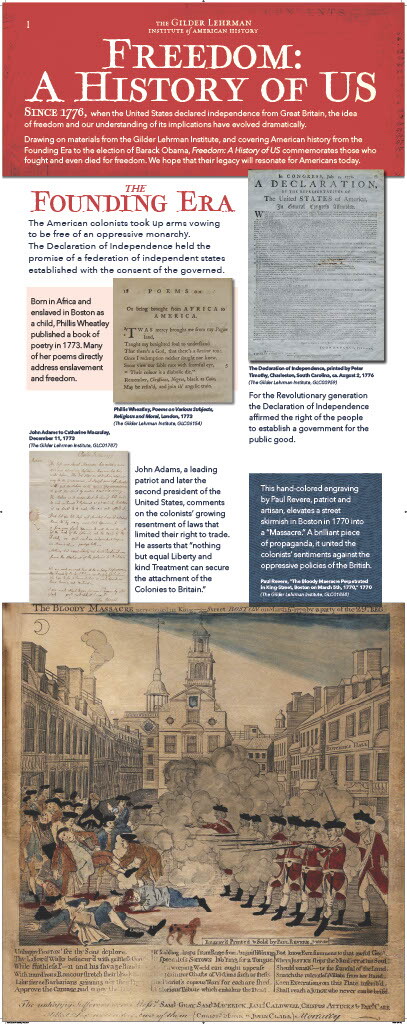
Panel Contents
- The Declaration of Independence, printed by Peter Timothy, Charleston, South Carolina, ca. August 2, 1776 (The Gilder Lehrman Institute, GLC00959)
- Phillis Wheatley, Poems on Various Subjects, Religious and Moral, London, 1773 (The Gilder Lehrman Institute, GLC06154)
- John Adams to Catherine Macaulay, December 11, 1773 (The Gilder Lehrman Institute, GLC01787)
- Paul Revere, “The Bloody Massacre Perpetrated in King-Street, Boston on March 5th, 1770,” 1770 (The Gilder Lehrman Institute, GLC01868)
Panel Two
The Young Republic
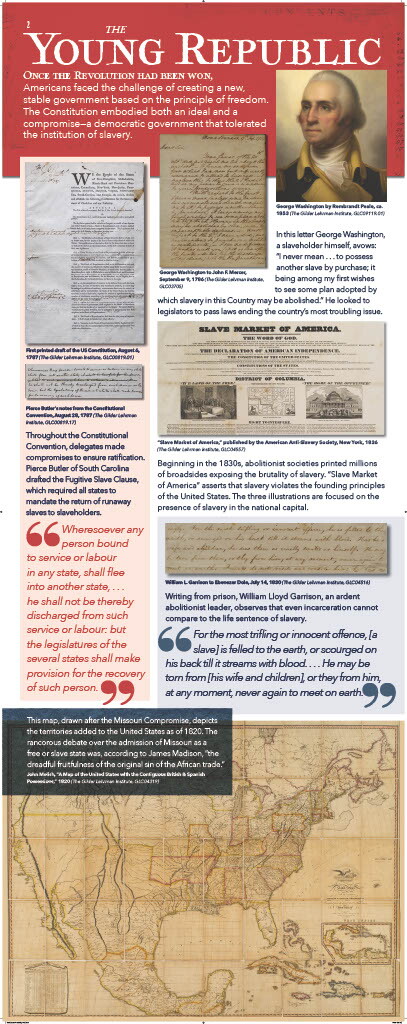
Panel Contents
- George Washington by Rembrandt Peale, ca. 1853 (The Gilder Lehrman Institute, ex-GLC09119.01)
- George Washington to John F. Mercer, September 9, 1786 (The Gilder Lehrman Institute, GLC03705)
- First printed draft of the Constitution, August 6, 1787 (The Gilder Lehrman Institute, GLC00819.01)
- Pierce Butler’s notes from the Constitutional Convention, August 28, 1787 (The Gilder Lehrman Institute, GLC00819.17)
- Quote from Pierce Butler
- Slave Market of America, published by the American Anti-Slavery Society, New York, 1836 (The Gilder Lehrman Institute, GLC04557)
- William L. Garrison to Ebenezer Dole, July 14, 1830 (The Gilder Lehrman Institute, GLC04516)
- Quote from William L. Garrison
- John Melish, A Map of the United States with the Contiguous British & Spanish Possessions, 1820 (The Gilder Lehrman Institute, GLC04319)
Panel Three
Toward the Abolition of Slavery
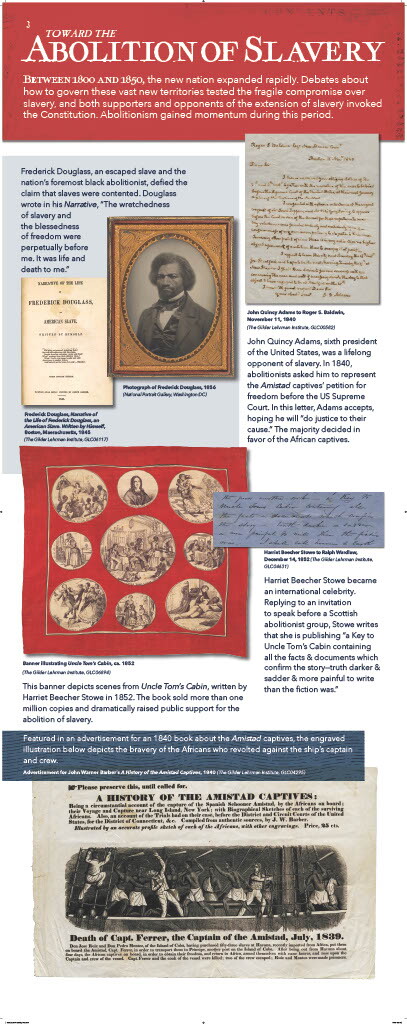
Panel Contents
- John Quincy Adams to Roger S. Baldwin, November 11, 1840 (The Gilder Lehrman Institute, GLC00582)
- Photograph of Frederick Douglass, 1856 (National Portrait Gallery, Washington DC)
- Frederick Douglass, Narrative of the Life of Frederick Douglass, an American Slave. Written by Himself, Boston, Massachusetts, 1845 (The Gilder Lehrman Institute, GLC06117)
- Harriet Beecher Stowe to Ralph Wardlaw, December 14, 1852 (The Gilder Lehrman Institute, GLC04631)
- Banner illustrating Uncle Tom’s Cabin, ca. 1852 (The Gilder Lehrman Institute, GLC06894)
- Advertisement for John Warner Barber’s A History of the Amistad Captives, 1840 (The Gilder Lehrman Institute, GLC04295)
Panel Four
The Breakdown of Compromise
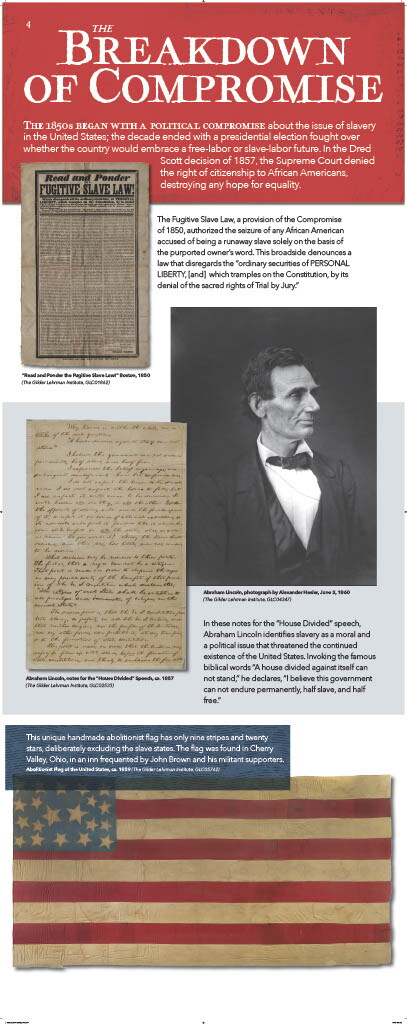
Panel Contents
- “Read and Ponder the Fugitive Slave Law!” Boston, 1850 (The Gilder Lehrman Institute, GLC01862)
- Abraham Lincoln, photograph by Alexander Hesler, June 3, 1860 (The Gilder Lehrman Institute, GLC04347)
- Abraham Lincoln, notes for the “House Divided” Speech, ca. 1857 (The Gilder Lehrman Institute, GLC02533)
- Abolitionist Flag of the United States, ca. 1859 (The Gilder Lehrman Institute, GLC05762)
Panel Five
The Union Threatened, The Union Preserved

Panel Contents
- “The Union Is Dissolved!” Charleston Mercury, extra edition, December 20, 1860 (The Gilder Lehrman Institute, GLC02688)
- Abraham Lincoln, telegram to Ulysses S. Grant, June 15, 1864 (The Gilder Lehrman Institute, GLC01572)
- Ulysses S. Grant and staff after Battle of the Wilderness, photograph by Alexander Gardner, June 1864 (The Gilder Lehrman Institute, GLC00588)
- “The Room in McLean House, at Appomattox C.H., in which Gen. Lee Surrendered to Gen. Grant,” published by Major & Knapp, New York, 1867 (The Gilder Lehrman Institute, GLC02979.01)
Panel Six
The Limits of Emancipation
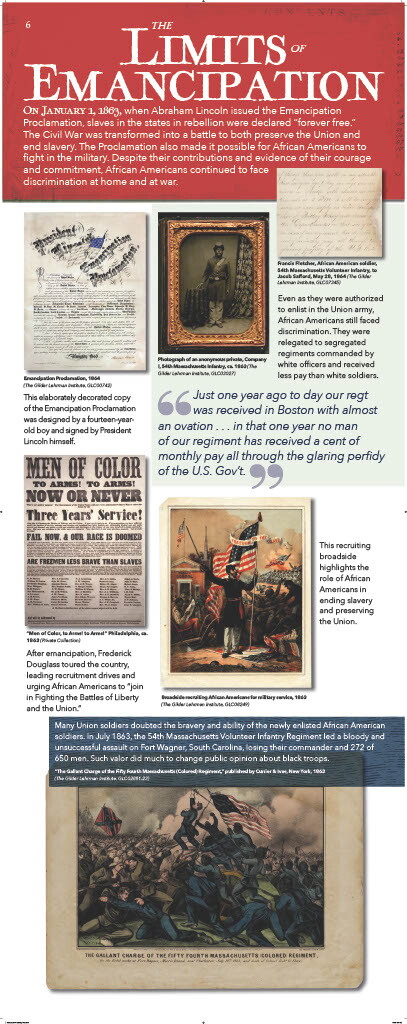
Panel Contents
- Francis Fletcher, African American soldier in the 54th Massachusetts Volunteer Infantry, to Jacob Safford, May 28, 1864 (The Gilder Lehrman Institute, GLC07345)
- Quote from Francis Fletcher
- Photograph of an anonymous private, Company I, 54th Massachusetts Infantry, ca. 1863 (The Gilder Lehrman Institute, GLC03027)
- Emancipation Proclamation, 1864 (The Gilder Lehrman Institute, GLC00742)
- “Men of Color, to Arms! To Arms!” Philadelphia, ca. 1863 (The Gilder Lehrman Institute, GLC10021)
- Broadside recruiting African Americans for military service, 1863 (The Gilder Lehrman Institute, GLC08249)
- “The Gallant Charge of the Fifty Fourth Massachusetts (Colored) Regiment,” published by Currier & Ives, New York, 1863 (The Gilder Lehrman Institute, GLC02881.23)
Panel Seven
The Price of Freedom

Panel Contents
- “A Harvest of Death” by Timothy O’Sullivan, July 1863 (The Gilder Lehrman Institute, GLC00244)
- David V. Smith to Elizabeth Smith, July 10, 1863 (The Gilder Lehrman Institute, GLC04189)
- Mary Kelly to Sarah Gordon, March 31, 1862 (The Gilder Lehrman Institute, GLC04197.25)
- Mary Kelly, wife of Union soldier James R. Kelly, [1860s] (The Gilder Lehrman Institute, GLC04197.40)
- “The President Is Dead!” New York, April 15, 1865 (The Gilder Lehrman Institute, GLC06680)
- President Lincoln’s funeral car, April 1865 (The Gilder Lehrman Institute, GLC05111.02.0042)
Panel Eight
Reconstruction and Its Legacies
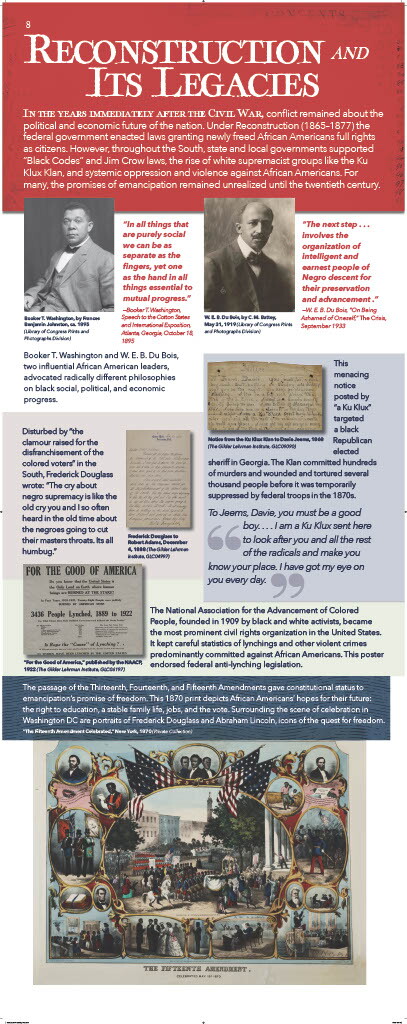
Panel Contents
- Booker T. Washington, Speech to the Cotton States and International Exposition, Atlanta, Georgia, October 1895
- Quote from Booker T. Washington
- Booker T. Washington, by Frances Benjamin Johnston, ca. 1895 (Library of Congress Prints and Photographs Division)
- W. E. B. Du Bois, “On Being Ashamed on Oneself,” The Crisis, September 1933
- Quote from W. E. B. Du Bois
- W. E. B. Du Bois, by C.M. Battey, May 31, 1919 (Library of Congress Prints and Photographs Division)
- Notice from the Ku Klux Klan to Davie Jeems, 1868 (The Gilder Lehrman Institute, GLC09090)
- Quote from the Ku Klux Klan to Davie Jeems
- Frederick Douglass to Robert Adams, December 4, 1888 (The Gilder Lehrman Institute, GLC04997)
- “For the Good of America,” published by the NAACP, 1922 (The Gilder Lehrman Institute, GLC06197)
- The Fifteenth Amendment Celebrated, New York, 1870 (Private Collection)
Panel Nine
Votes for Women
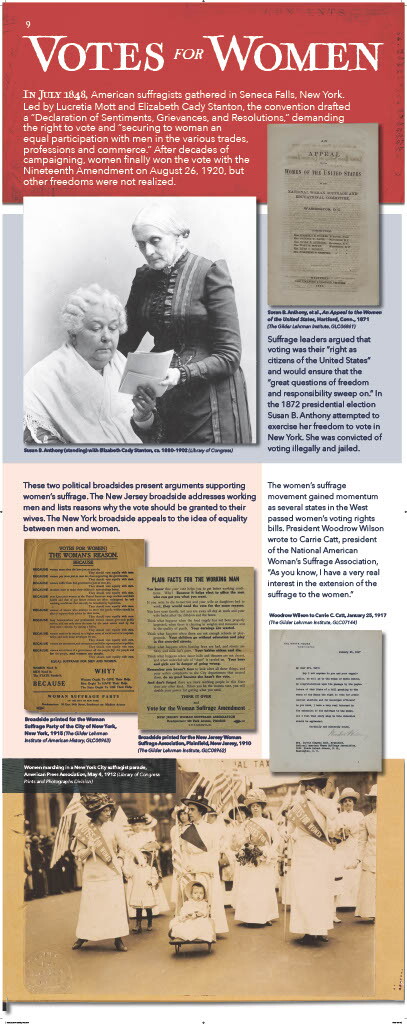
Panel Contents
- Susan B. Anthony, et al., An Appeal to the Women of the United States, Hartford, Conn., 1871 (The Gilder Lehrman Institute, GLC06861)
- Susan B. Anthony (standing) with Elizabeth Cady Stanton, ca. 1880–1902 (Library of Congress)
- Woodrow Wilson to Carrie C. Catt, January 25, 1917 (The Gilder Lehrman Institute, GLC07144)
- Broadside printed for the Woman Suffrage Party of the City of New York, New York, 1915 (The Gilder Lehrman Institute, GLC08963)
- Broadside printed for the New Jersey Woman Suffrage Association, Plainfield, New Jersey, 1910 (The Gilder Lehrman Institute, GLC08962)
- Women marching in New York City suffragist parade, American Press Association, May 4, 1912 (Library of Congress Prints and Photographs Division)
Panel Ten
Fighting for Freedom at Home and Abroad
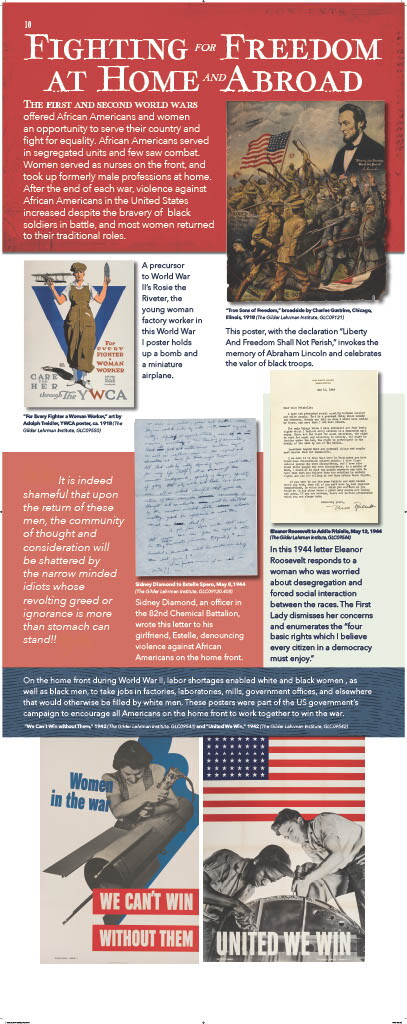
Panel Contents
- “True Sons of Freedom,” broadside by Charles Gustrine, Chicago, Illinois, 1918 (The Gilder Lehrman Institute, GLC09121)
- “For Every Fighter a Woman Worker,” art by Adolph Treidler, YMCA poster, ca. 1918 (The Gilder Lehrman Institute, GLC09550)
- Eleanor Roosevelt to Addie Frizielle, May 13, 1944 (The Gilder Lehrman Institute, GLC09544)
- Sidney Diamond to Estelle Spero, May 8, 1944 (The Gilder Lehrman Institute, GLC09120.408)
- Quote from Sidney Diamond
- “We Can’t Win without Them,” 1942 (The Gilder Lehrman Institute, GLC09543)
- “United We Win,” 1942 (The Gilder Lehrman Institute, GLC09542)
Panel Eleven
The Civil Rights Movement
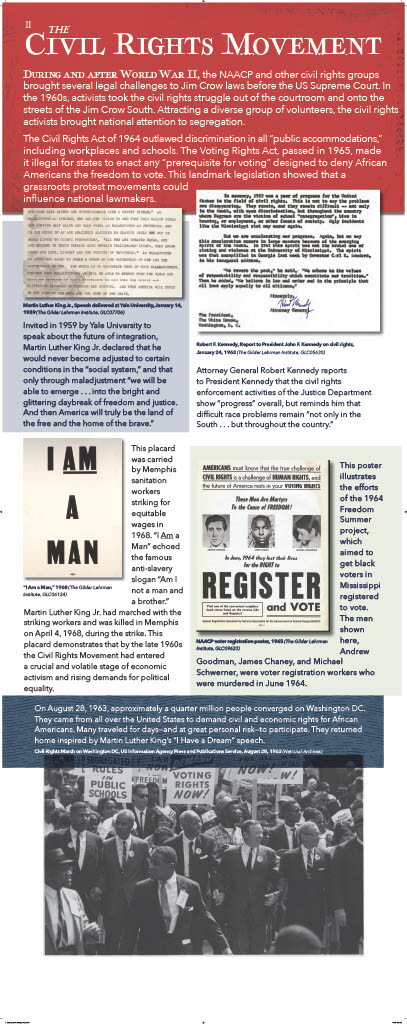
Panel Contents
- Martin Luther King Jr., Speech delivered to Yale University, January 14, 1959 (The Gilder Lehrman Institute, GLC07706)
- Robert F. Kennedy, Report to President John F. Kennedy on Civil Rights, January 24, 1963 (The Gilder Lehrman Institute, GLC05630)
- “I Am a Man,” 1968 (The Gilder Lehrman Institute, GLC06124)
- NAACP voter registration poster, 1965 (The Gilder Lehrman Institute, GLC09623)
- Civil Rights March on Washington, DC, US Information Agency Press and Publications Service, August 28, 1963 (National Archives)
Panel Twelve
The Road to Equality
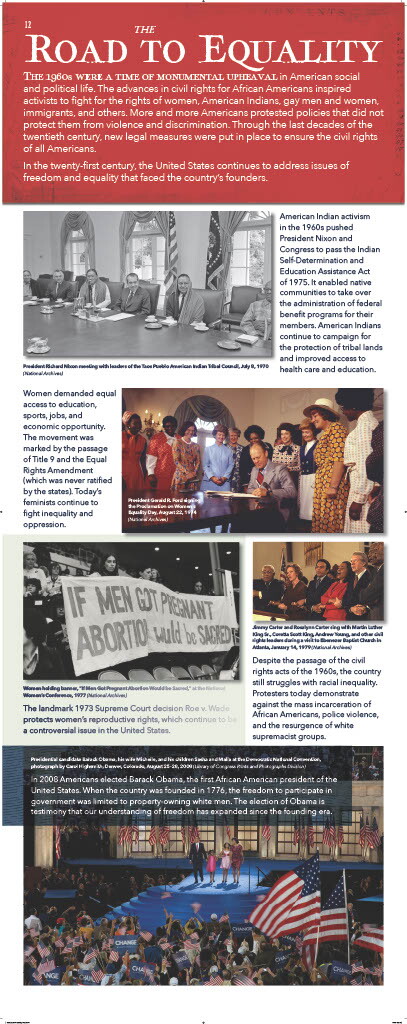
Panel Contents
- President Richard Nixon meeting with leaders of the Taos Pueblo American Indian Tribal Council, July 8, 1970 (National Archives)
- President Gerald R. Ford signing the Proclamation on Women’s Equality Day, August 22, 1974 (National Archives)
- Jimmy Carter and Rosalynn Carter sing with Martin Luther King Sr., Coretta Scott King, Andrew Young, and other civil rights leaders during a visit to Ebenezer Baptist Church in Atlanta, January 14, 1979 (National Archives)
- Women holding banner, “If Men Got Pregnant Abortion Would be Sacred,” at the National Women’s Conference, 1977 (National Archives)
- Presidential candidate Barack Obama, his wife Michelle, and his children Sasha and Malia at the Democratic National Convention, photography by Carol Highsmith, Denver, Colorado, August 25–28, 2008 (Library of Congress Prints and Photographs Division)
Frequently Asked Questions
If you need more information, please fill out this traveling exhibitions inquiry form. We strive to respond to inquiries within one business day.
Setup Guide
General Questions
Do I need to pay sales tax?
State sales tax laws vary. You may be liable for sales taxes. The Gilder Lehrman Institute will contact you about your potential sales tax obligations.
How can I pay?
We accept credit cards, checks, and purchase orders, but we do not currently accept bank transfers.
Do you offer any discounts or grants?
Unfortunately, we are unable to offer any discounts or grants at this time. We recommend DonorsChoose for schools that need financial assistance to rent or purchase an exhibition.
How do you ship the exhibitions?
Exhibitions are shipped in wheeled cases measuring 15 x 15 x 40 inches and weighing approximately 90 pounds. FedEx handles all shipping. Once your exhibition has shipped, you will receive a tracking number.
How do I set up the exhibition?
We include detailed setup instructions with each rental. Please note that different exhibitions have slightly different setup instructions, so make sure you refer to the correct type of exhibition.
What happens if something breaks after I receive my exhibition?
We are always here to help you troubleshoot or order new parts. The venue will bear the costs of replacement parts due to venue error or excessive wear and tear.
Purchase
What materials are included in my exhibition purchase?
With your purchase, we will order a brand-new exhibition to send to you. Each panel comes in its own zipped sleeve for storage and transport. You will also receive all the supplementary materials typically included with a rental, including the Exhibition Guide and setup instructions.
Does my purchased exhibition come with the travel/storage case?
The travel/storage case is a separate purchase. You can add a case for your exhibition for an additional $500 on the same menu where you bought the exhibition. All exhibitions can fit into one case, except for Freedom: A History of the US, which requires two.
Is shipping included in the purchase price?
Yes!
Can I purchase a “used” exhibition instead of a new one for a lower price?
Unfortunately, this is not currently an option, as all of our existing exhibitions are part of our rental stock. If your school needs financial assistance to purchase an exhibition, we recommend checking out DonorsChoose.
How long will it take to receive my exhibition?
Once we receive payment, please allow 2 weeks to print and ship your new exhibition. Exhibition orders are not sent for printing until we receive payment in full.
Rental
How long is the rental period?
4 weeks. Please let us know if you would like a longer booking period, and we will do our best to accommodate you! However, we cannot offer discounts for shortened booking periods.
How far in advance should I book my rental?
It is recommended to book 2–3 months in advance of your desired rental date, but we can accept bookings up to a year in advance. Please note that we do not ship exhibitions until payment is received in full, so please keep this in mind when booking your exhibition.
What is included in my rental fee?
The rental cost is a flat fee that covers shipping, the exhibition, and supplemental materials. Extra charges will only occur if a venue damages an exhibition.
Can I bring the exhibition to multiple venues during my rental period?
Exhibitions are limited to the location booked in the contract. While you’re free to relocate the exhibition to different buildings or rooms within your contracted location, we do not permit any other circulation of the exhibition. If you need to feature an exhibition at various locations, we recommend purchasing it rather than renting it.
Can I reschedule my rental?
If your new rental dates are available, we will happily reschedule your rental, provided the exhibition has not already shipped to you.
How do I ship the exhibition back to you?
We’ll send you a FedEx label up to 10 days before the end of your display period and set up a pickup appointment for your exhibition return. Please remove any existing labels from the case before attaching the new one, and notify our team if there are any special instructions for FedEx.
